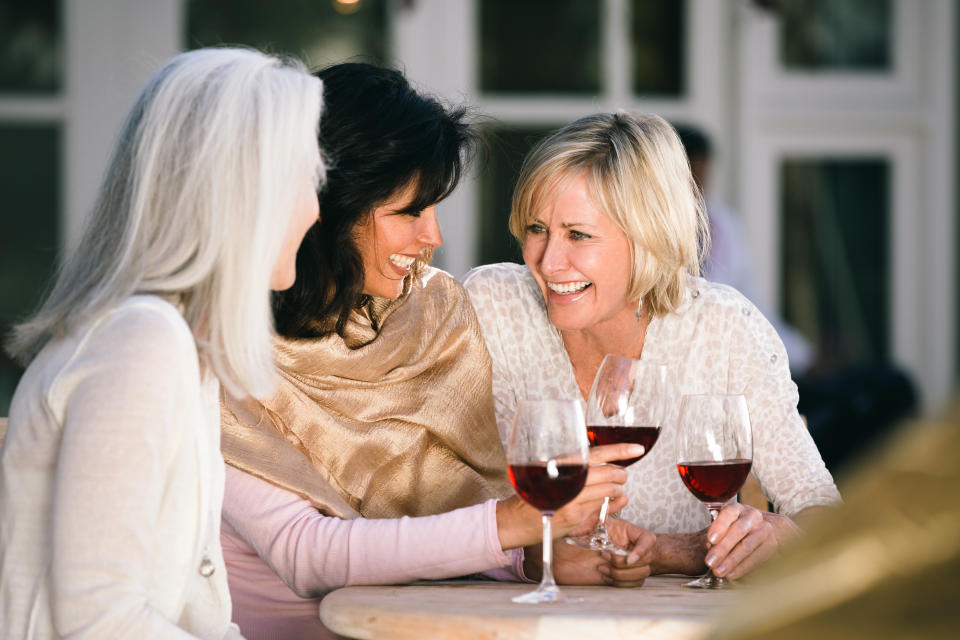The Face Of Binge Drinking In America Is A 60+ White Woman
Summer ― the season of binge-drinking ― is upon us. And who is likely to be knocking back more than a few? Older women, according to a study by the National Institute on Alcohol Abuse and Alcoholism.
More older American women are drinking — and drinking more heavily. The number of women over 60 who binge drink has been rising at a pace that rivals the sea-levels ― and exceeding the rate for older men.
Researcher Rosalind Breslow of the NIAAA studied drinking patterns among 65,000 men and women 60 and older between 1997 and 2014. The percentage of women who binge-drink jumped almost 4 percent a year, while the proportion of men who did the same remained steady. There were still more binge-drinking men than women, though ― 1,700 women to more than 6,500 men.
Binge drinking is a pattern of drinking that brings a person’s blood alcohol concentration (BAC) to 0.08 grams percent or above. This typically happens when men consume 5 or more drinks, and when women consume four or more drinks, in about 2 hours. A drink is 1.5 ounce of spirits, 5 ounces of wine, or 12 ounces of beer.
The study authors speculated about the reasons for the increase and the usual suspects were rounded up: loneliness as women outlive their spouses, financial concerns in retirement based on limited career earnings, caregiving that fuels stress, and empty nest syndrome when children not only leave for college, but settle in other parts of the country for jobs. While valid, all those reasons relate to the roles women have traditionally played.
Some even see the increase in drinking among women to be an offshoot of progress in other areas. Women born after World War II were more likely to go to college and join the workforce than before. Greater work opportunities of course means greater occupational stress ― and women may be looking at alcohol to relieve stress. Cardiovascular disease is now the number one cause of death among women.
Or the push toward heavier drinking could be the result of this simple shift: As the stigma once attached to women’s drinking disappeared, more alcohol advertising was directed at them.

Last year, The Washington Post took a look at how alcohol was being marketed to women, and noted that, “Instead of selling alcohol with sex and romance, these [social media] ads had an edgier theme: Harried mothers chugging wine to cope with everyday stress. Women embracing quart-sized bottles of whiskey, and bellying up to bars to knock back vodka shots with men.”
The Post reported that this new kind of advertising made the association between women’s liberation and heavy drinking, and said it both heralded and promoted a profound cultural shift: “Women in America are drinking far more, and far more frequently, than their mothers or grandmothers did, and alcohol consumption is killing them in record numbers.”
White women are particularly likely to drink dangerously, with more than 25 percent drinking multiple times a week and the share of binge drinking up 40 percent since 1997, according a Washington Post analysis of federal health data. In 2013, more than a million women of all races wound up in emergency rooms as a result of heavy drinking, “with women in middle age most likely to suffer severe intoxication,” the Post reported.
Whatever is prompting the uptick in women’s binge drinking, the end result is that it’s not good for their health. Women have a higher blood alcohol concentration than men at any level of alcohol consumption, and are more likely to suffer the consequences of alcohol abuse. For example, the risk of alcohol-related liver diseases and memory loss is higher for women than for men, according to the Centers for Disease Control and Prevention.
Most health authorities recommend that women limit their alcohol consumption to seven drinks a week, with no more than three drinks at one sitting.
The study results were reported online March 24, 2017, by Alcoholism: Clinical and Experimental Research.
Love HuffPost? Become a founding member of HuffPost Plus today.
This article originally appeared on HuffPost.

